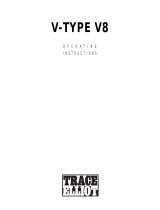
24
www.ashdownmusic.com www.ashdownmusic.com
25
USER MANUAL
VALVE
THE VU METER
The VU meter tted to the CTM is a dual function meter detailed as
follows:
By using the push button selector switch marked “AUDIO / BIAS” the
functions are accessed in the following manner:
1/ “AUDIO” - In audio mode the meter is set to read the audio output of
each of the six power tubes and each can be measured by utilising the
rotary selector switch on the front panel. Whilst playing this is the normal
mode of operation of the meter and the reading obtained will be a direct
indication of the power being produced by each output tube, the meter
is calibrated so that when the needle reaches the start of the red section
the power tube being measured will be producing maximum clean
volume.
The switch can be rotated to select any of the power tubes and its relative output will be indicated on the meter, note that when
performing this test you will need to play at equal volume for each test.
2/ “BIAS” - In this mode the meter will glow RED.
To check the bias of the output tubes proceed as follows:
Run the amplier for at least 10 mins to allow the output tubes to fully heat up with the amplier set to mute. Standby on.
Select.. Tube 1 and with an insulated jewelers screwdriver gently adjust the trimmer situated on the rear panel. The reading to
aim for is the needle just at the start of the red ie 0db.
Note that although each tube can be adjusted individually it is possible to get tubes that cannot be adjusted to the correct
reading, these can still be used providing the reading is not in the red, a lower reading is acceptable and will note impact audibly
on the power output or sound quality of the amplier.
Please also note that the trimmers are 25 turn types to make adjustment easy, This type of adjuster has no end stop so if you
reach a point where the adjuster will not give any more adjustment then the output tube will have to be replaced if the reading
is to high ie in the RED.
Repeat this for each of the six output tubes in turn.
RETURN THE METER TO “audio” MODE AFTER BIASING. DO NOT RUN THE AMPLIFIER IN BIAS MODE WHILST PLAYING.
Note there is a protection fuse tted to each of the output tubes and if no reading is obtained on the meter this fuse will have
AT REDUCED
POWER
IDEAL SETTING KEEP OUT!
DO NOT SET ANY
TUBE THIS HIGH
CTM-300/100
Face avant
Inputs
Vous disposez d’une entrée et d’un interrupteur vous permettant de
choisir le type d’impédance de l’instrument utilisé. Passive et Active.
Le mode Passif (interrupteur relâché) offre une haute sensibilité et
une haute impédance pour s’adapter aux basses passives. Le mode
actif (interrupteur enfoncé) offre une sensibilité et une impédance
nettement plus basse afin de correspondre au signal provenant
d’une basse active.
Input COntROL
Le réglage input control permet de définir le niveau du signal
d’entrée dans le préampli en coordination avec le vu- mètre; Il
doit être réglé de façon à ce que la valeur moyenne soit 0vu et
en obtenant des pics occasionnels en zone rouge. Notez que ces
paramètres pourront être réajustes après avoir modifié les valeurs
d’égalistation.
pusH FLAt/sHApE
En position relâché, ce bouton enclenche un circuit de pré-
égalisation fixe qui donne au son une certaine clarté et un caractère
punchy. Appuyer sur ce bouton pour obtenir une égalisation plate.
Cette fonction peut également être contrôlée par une pédale, pour
que la pédale soit opérationnelle le bouton doit être en position off.
VALVE DRIVE
Cette fonction permet d’acheminer le signal soit vers une section
d’amplificateur à transistors (son clair), soit vers une section
d’amplification à lampes double triode afin d’y ajouter du
caractère; de la chaleur avec un réglages à 9h ; un léger grain
sur 12h ; et jusqu’à la saturation des lampes lorsque le réglage est
amené au maximum.
Un mélange des deux sections d’amplification peut être réalisé avec
ce réglage.
N.B : la quantité de saturation est également dépendante du
réglage du gain d’entrée.
VALVE DRIVE/In Out
Ce bouton active/désactive la fonction Valve Drive. Cette fonction
peut également être accessible à partir du pédalier FS4 en option
(pour que le pédalier fonctionne, cette fonction doit être désactivée).
EQ In/Out
Ce bouton active ou désactive la section Egalisation. Cette fonction
peut également être accessible à partir du pédalier FS4 en option
(pour que le pédalier fonctionne, cette fonction doit être désactivée).
EQuALIsER
La section d’égalisation comprend les réglages « BASS/
MIDDLE/ TREBLE» (Graves/ Mediums/ Aigus) et les deux jeux de
potentiomètres linéaires placés entre ceux-ci.
Vous pouvez utiliser cet égaliseur de deux manières différentes :
1- Comme un simple réglage des tonalités graves, médiums
et aigües, que l’on trouve traditionnellement sur nombre
d’amplificateurs classiques. Vous laisserez alors les deux jeux de
potentiomètres linéaires placés entre ceux-ci en position centrale et
n’utiliserez que les boutons « BASS/ MIDDLE/ TREBLE» (Graves/
Mediums/ Aigus) pour régler la tonalité générale.
2 - Comme un égaliseur polyvalent, simple à comprendre et à
régler. En plus des réglages « BASS/ MIDDLE/ TREBLE», vous
utiliserez les deux jeux de potentiomètres linéaires placés entre
ceux-ci qui vous permettront de façonner le son à votre guise, en
travaillant sur le Bas et le Haut medium. Cette section se caractérise
donc par la simplicité d’un réglage de tonalité à trois boutons avec
la flexibilité d’un égaliseur graphique.
COMpREssIOn
L’ajout d’une faible quantité de compression vous permet de donner
un son beaucoup plus profond et de jouer à un volume plus élevé
sans attaquer les cordes plus fort ce qui permet d’éviter les pics de
distorsion de l’étage de sortie de l’amplificateur.
Vous trouverez également que le son sera plus défini en mettant
en valeur la dynamique de votre jeu et en offrant également une
meilleur définition.
Face arrière














